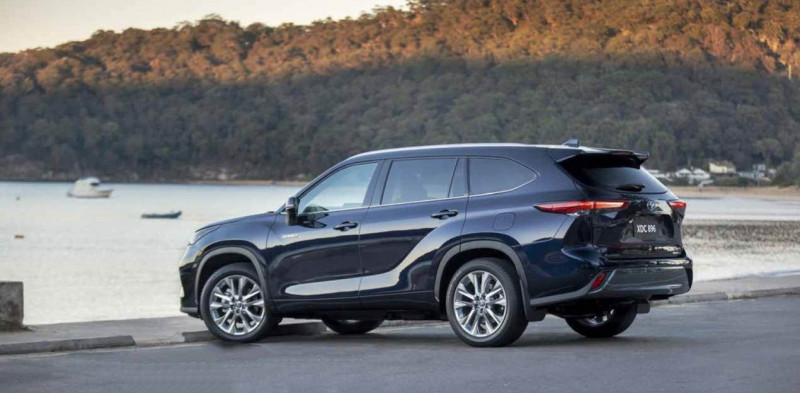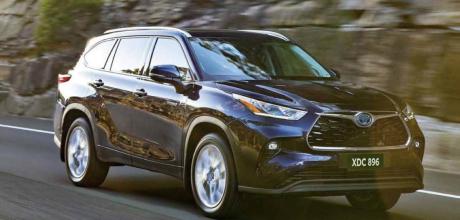2022 Toyota Kluger
Among Toyota’s myriad multi-seater options, the fourth-generation Kluger installs itself as the singular car-based choice for Aussie buyers more focused on crossing suburbs than going cross-country.
And a new, headline-making hybrid drivetrain combines with the imminent axing of the Prius V people-mover to establish the large SUV as the only petrol-electric Toyota with seven or more seats.

Toyota’s hybrid system is well overdue as an alternative to a V6 petrol that has powered the Kluger in Australia since its 2003 debut. It’s been available in the US, where it’s called Highlander, for a decade and a half.
Kluger Hybrid’s ability to self-charge, via both the petrol engine and regenerative braking, is a double-edged sword
Not that the omission has cruelled local sales. While Toyota Australia expects the hybrid to become the dominant drivetrain in a sales mix that includes the carry-over V6, the Kluger hasn’t been toppled since 2013 when it was outsold by the Ford Territory. Despite being consistently outsold by its 4WD Prado stablemate, the Kluger will pass 200,000 local sales with this latest model.

Pricing has gone up, however, across a range that again comprises GX, GXL and Grande trim grades. For a model that once started below $40,000, the Kluger now starts a bit higher than most of its direct rivals like the Kia Sorento. Priced from $47,650, Kluger’s higher grades now take the nameplate past $70,000 for the first time.
All three grades start as a front-wheel- drive V6, with a $4000 premium for all-wheel drive and a further $2500 for the AWD Hybrid.
The most affordable Hybrid is priced from $54,150, more than $17,000 higher than the entry-level petrol-electric RAV4. The range-topping Grande Hybrid will set buyers back more than $80,000 with on-road charges added. Natural rivals remain the likes of the Kia Sorento, Hyundai Santa Fe and Mazda CX-8, though a 76mm increase in body length also takes the Kluger closer in size to Hyundai’s larger Palisade as well as the Mazda CX-9.
Luggage space behind the third row has increased by 46 litres to 241 litres – ample space to accommodate a family’s weekly grocery shop or multiple sports/ school bags.
Drop the 50/50 rearmost seats, via flap-style levers on the seat shoulders, and boot space moves from above average to a below-average 552L with five seats in use. Even most RAV4s offer up to 580L.
Access to the third row is wider than many rivals, making ingress/egress relatively easy. The second-row seats tilt/slide forward in one step via the same style of lever as the back seats, though SUVs such as the Sorento and Palisade provide cleverer, one-touch electric-release tumble operation. Longer travel for the sliding 60/40 second row makes it easier to give third-rowers some semblance of knee space.
There’s more legroom than you’ll find in the Sorento or Santa Fe, and unlike them the Kluger’s curtain airbags fully cover the third row, not just the glass area. Toe space is good, and there are ceiling air-con outlets.
It’s still a cosy, knees-up affair even for average-height adults, while the third row’s versatility is limited by the lack of child-seat anchor points, which some competitor vehicles offer.
The previous Kluger was a roomy SUV, yet the 60mm added to the wheelbase for this new model makes the second row feel truly spacious. Although storage options aren’t limited – and the front cabin’s 15-litre console box is particularly useful – there are rival SUVs with smarter cabin practicality, notably the Sorento.
Virtually every competitor offers better cabin technology, too. The Kluger’s infotainment system is formed around an 8.0-inch touchscreen that’s at least 20 percent smaller than in rivals, and offers up uninspiring graphics and poor resolution. The inclusion of Apple CarPlay and Android Auto are no excuse, especially when, as we discovered, some phones are seemingly incompatible.
Kluger doesn’t follow the modern trend with a fully digital instrument cluster, either, and only the Grande comes with a head-up display.
The Grande cabin is given extra lashings of leatherette, which creates a higher perception of quality without allowing the Kluger to match the more luxurious vibe of a CX-9 Azami or even the class of the less-expensive Sorento GT-Line or Peugeot 5008 GT.
Fake, plastic wood trim and the absence of LED interior lighting don’t help, while the Grande’s leather-accented seats aren’t of the Nappa variety commonly found at this price point. The front seats also lack cushion extenders and, ironically, can’t match the comfort and support of the base GX’s fabric seats.
Not every buyer will be fussed about a contemporary-looking interior, and few again will be bothered that Toyota’s 3.5-litre has been around the block a few times and retains the 218kW/350Nm outputs and eight-speed auto of the previous Kluger.
The V6 is the pick over the Hybrid for those who prioritise performance. Toyota says the FWD V6 is the fastest-accelerating Kluger, using its near- 100kg-lighter kerb weight to nullify the AWD V6’s traction advantage – 7.5 seconds playing 7.8 in the 0-100km/h run. Or versus 8.4sec for the Hybrid. There’s some minor torque steer in the front-drive V6 and a sunny day meant we couldn’t assess whether this variant, like its predecessor, has a propensity to spin its wheels excessively in the wet.
The V6 certainly remains a smooth and pleasant-sounding engine, with a clear rolling acceleration advantage over the Hybrid.
A stop-start system improves the V6’s official fuel consumption, which is now as low as 8.7L/100km. That’s still well above the Hybrid’s 5.6L/100km – an efficiency advantage likely to be magnified in everyday driving.
We got close to that lab-derived number too, registering an indicated 5.9L/100km after about 100km of inter-suburban driving, and never climbing higher than 6.4L/100km after further weekend suburban driving with some family members aboard. A separate country road drive, where the hybrid system is more reliant on the petrol engine, still registered only 6.7L/100km.
Toyota has equipped the Kluger with essentially the same hybrid set-up as the RAV4 AWD, though with the wick turned up. The larger SUV has combined power of 184kW compared with 163kW.
An important note for those anticipating lower fuel bills, however, is that the tweaks have resulted in the 2.5-litre four-cylinder requiring premium (95 RON) unleaded.
On a light throttle, the hybrid drivetrain with an e-CVT transmission feels more responsive initially than the V6 but needs to be stirred more for performance – which comes at the expense of refinement. The petrol four also becomes overly intrusive with its gruff nature.
It’s difficult to prevent the petrol engine kicking into life even at low speeds, and the EV Mode that prompts the car’s computer to stay with electric power cancels itself at just 30km/h. The Kluger Hybrid’s ability to selfcharge, via both the petrol engine and regenerative braking, is a doubleedged sword. Although this simplifies the ownership experience, Kia’s forthcoming Sorento plug-in hybrid promises even better efficiency, much lower emissions and up to 70km of pure electric urban driving.
It is possible to run at higher speeds using the electric motors only, on a flattish road, once the Kluger has momentum, with Toyota’s hybrid system switching seamlessly between its dual forms of power as it has done ever since the early days of the Prius.
When the Kluger is coasting/ cruising, the drivetrain’s near-silence is complemented by minimal noise from the tyres on coarser surfaces. This includes the Grande’s 20-inch wheels, which also avoid spoiling the wonderfully relaxed suppleness of the Kluger’s suspension.
With smooth, effortless steering and good body control, the Kluger becomes the latest Toyota nameplate to have had its driving manners transformed by the company’s TNGA modular platform – if never feeling as tied down on a country road as Mazda’s CX-9.
All-wheel-drive systems differ between models, with the Hybrid’s axles unconnected and instead using an extra electric motor for the rear wheels. V6 models feature Rock/Dirt and Mud/Sand modes; Hybrids have a Trail mode to aid traction.
Hybrid or not, serious off-roading families are just unlikely to cross-shop the Kluger with alternative seven-seater Toyotas better equipped to cross multiple types of terrain.
The rival
KIA SORENTO PHEV $75,000 (ESTIMATED)
Kia’s excellent seven-seater Sorento will provide the most directly comparable alternative to Kluger when the hybrid and plug-in hybrid arrive later this year. The PHEV teams a 132kW/265Nm 1.6-litre turbo-petrol four to a transmission-mounted electric motor for a combined 195kW/350Nm, sent to all four wheels via a six-speed auto. The motor is fed by a 13.8kWh lithium-ion battery, providing an all-electric range of 57km on Europe’s WLTP cycle. Kluger struggles to manage 1km at crawling speed in EV mode.
New Kluger comes with safety essentials sorted, but there are some lapses in terms of equipment and attention to detail that jar, especially in light of the ambitious prices.
Sensible chassis tuning and Toyota’s fi ne TNGA platform mean Grande’s 20-inch wheels don’t bugger the ride.
Top shelf
GEAR, HERE
While the base GX’s features cupboard is far from threadbare, there’s plenty to lure buyers into higher grades. Mid-range GXL adds climate control for the second row, electric front seats with heating, navigation, auto tailgate, and replaces GX’s cloth seats with artificial leather.
The top-grade Grande’s extensive extras include a panoramic roof, 20-inch wheels, leather-accented upholstery, ventilated front seats, second-row blinds, head-up display, and JBL audio. Aside from metallic paint, a $1500 Blu-Ray rear entertainment system is the sole option – for Grande only. Although the Kluger now provides more equipment including increased safety features, it’s not difficult to find rival seven-seater SUVs with standard-kit advantages.
PLUS + Ride comfort; Hybrid’s fuel economy; spacious cabin
MINUS — Pricey; small touchscreen; patchy cabin versatility/functionality


